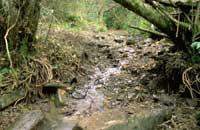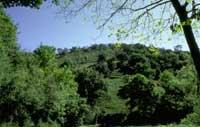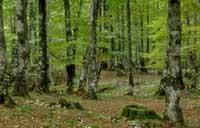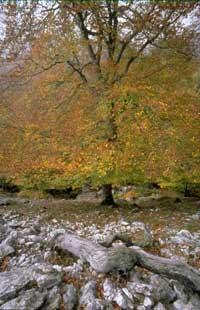No trees no shade

10,000 years ago half of the Earth's surface was covered by forests. Since then, humans have grown a lot and forests have declined a lot: today only 33% of the area is forest. 90% of Central America's tropical forests have disappeared and in the Amazon rainforest a surface similar to Europe has been destroyed in recent years. However, tropical forests are not the only ones in danger, most American forests have also been lost: 90% of US forests and 60% of Canadians are depressed. At the European level, 80% of the natural forests of eastern and central Europe had disappeared by the end of the Middle Ages. Currently, only 2% of Europe's forest area is own, that is, only 2% of the forests we have have have not been affected by man. Another 98% is an altered forest that is also in danger of deforestation.
In Euskal Herria, especially on the Atlantic side, forests have suffered continuous degradation in the last 250 years. Inadequate agricultural techniques and industrial overexploitation of forests destroyed almost all the forests of Bizkaia and Gipuzkoa in the 19th century. at the end of the 20th century.
At present, 56% and 59% of the forest areas of Bizkaia and Gipuzkoa respectively, but 65.5% of them are planted pine forests. For its part, in Álava and Navarra, although the forest area is less -47% and 33% respectively, the presence of natural forests in these provinces is greater. Oak, beech, marojales, holm oaks, quejigales and alisedas are the typical forests of Euskal Herria.

The forests protect the soil from erosion, absorbing rain and curbing wind force.
Green trees and plants perform photosynthesis to live and during the process absorb carbon dioxide from the atmosphere, one of the agents causing the greenhouse effect, generating oxygen at the same time. This allows to maintain a balance between the gases that form the atmosphere. In addition, a large percentage of Earth's primary production occurs in forests: 45% of the dry organic matter generated on the planet is produced in forests. Forests are home to many animals and plant species and, as in all ecosystems, the relationship between the forest and its inhabitants is very close. Forests allow us to collect and eat mushrooms and chestnuts in autumn, enjoy a landscape of bright red colors and shelter under the shade of a beautiful summer sun tree. Forests perform important biological, ecological and, why not, social functions, so we must take care of them.

European countries pledged to conserve forests at the Rio de Janeiro Environmental Summit in 1992 and a year later in Helsinki. It was decided to conserve and conserve forests and biodiversity and roads were opened for sustainable management of forests and their wealth. Since then the situation of forests has improved and Europe is greener. But the fact that there are more forests does not mean that they are adequate, since quality is more important than quantity. Forests are often treated with more order and cleanliness than nature needs, that is, dead or empty trees are removed and fallen branches are collected.
On other occasions, monospecific tree forests have been planted, placing trees one after another in a straight line. Excess cleaning and order leaves many animals and forest plants homeless.

The WWW/Adena organization has analyzed the forest policy of 19 countries signing the Helsinki agreement and published the results last December. For the preparation of the report, the agreed objectives in Helsinki have been taken as a starting point, which have configured a scoring system of one to one hundred. The report concludes that none of the countries analyzed adequately care for forests. The highest score of the study was obtained by Switzerland with 62 points and the lowest Estonia with 38 points. The average of all countries is 51 points, that is, quite if the countries were in school, but very little from the forest point of view.
Of each country 99 different elements have been analyzed and grouped into 5 criteria: forestry and production, environment, management of the socio-cultural function of forests, protected areas and pollution. The individualized analysis of the criteria presents significant differences in each country and in each country. What one country does well the other does wrong and vice versa, but the overall result is the one mentioned above: European countries do not adequately care for forests and much remains to be done.
Among the problems affecting our forests are pollution, the evident shortage of natural and semi-natural forests, the scarce number of protected forests, the excessive use of pesticides and herbicides and the lack of dead wood. Forestry and wood production is done erroneously in all countries: a higher quantity of wood is sought and wood products are driven more than wood products. In many places monospecific forests are cultivated and cared for, which impacts biodiversity. Dead wood, habitat of many forest species, is also very scarce in all European countries. The other common problem that European countries have is the lack of information, that is, although everyone committed to collecting data on forests, the commitment has become a small measure and most countries have not received enough information. Consequently, forest conservation and recovery plans are based on incomplete data and incomplete work is done with incomplete data.

The report has also made it clear that ecological awareness and clean work sometimes do not coincide. Holland and Great Britain, countries with supposedly high ecological awareness, are on the list of 16 and 17 respectively. On the other hand, the work of the peoples of northern Europe is no better than that of the southern countries, nor that of the western countries of Europe is more adequate than that of the eastern countries. But, as WWF has pointed out, the aim of the report is not to classify and compete with European countries, but to identify problems and find solutions. Export what we have done well and bring what they have done well to us, that is the way, and not say that you have done it worse than me and stay calm.
Published in the supplement Natura de Gara
Buletina
Bidali zure helbide elektronikoa eta jaso asteroko buletina zure sarrera-ontzian











